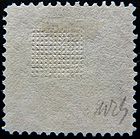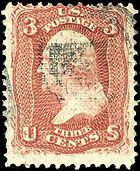
Grill (philately)
Encyclopedia

Postage stamp
A postage stamp is a small piece of paper that is purchased and displayed on an item of mail as evidence of payment of postage. Typically, stamps are made from special paper, with a national designation and denomination on the face, and a gum adhesive on the reverse side...
is an embossed pattern of small indentations intended to discourage postage stamp reuse
Postage stamp reuse
In the earlier days of the postage stamp, postal officials worried much about the problem of postage stamp reuse, and invented a number of schemes to mark or deface the stamps....
. They were supposed to work by allowing the ink of the cancellation to be absorbed more readily by the fibers of the stamp paper
Postage stamp paper
Postage stamp paper is the foundation or substrate of the postage stamp to which the ink for the stamp's design is applied to one side and the adhesive is applied to the other...
, making it harder to wash off the cancellation.
In the United States
The best-known examples of grilling are the United StatesUnited States
The United States of America is a federal constitutional republic comprising fifty states and a federal district...
issues of the late 1860s and early 1870s, when grilling was standard for all US stamps. While many types of grilled stamps are common, certain of the grill patterns were little-used, and define some of the great rarities of philately. In particular, the 1-cent stamp with the "Z" grill is generally cited as the rarest of all US stamps (only two copies are known), and is commonly known simply as the Z Grill
Z Grill
The Benjamin Franklin Z Grill, or simply "Z-Grill", is a 1-cent postage stamp issued by the United States Postal Service in February 1868 depicting Benjamin Franklin. While stamps of this design were the common 1-cent stamps of the 1860s, the Z-Grill is distinguished by having the so-called "Z"...
. A recently discovered grill issue, the 30-cent "I" grill stamp, may be even rarer, for only one example has thus far been identified.
The idea of grilling was first suggested by Charles F. Steel, a supervisor at the National Bank Note Company, with correspondence on the subject dating from 1865.
The first type of grill to be tried, termed by philatelists the "A" grill, was applied to the entire stamp. Stamps so treated were distributed to post offices for testing in August 1867, and apparently satisfactory, as National received a contract stipulating use of grilling for all stamps. However, the actual practice of grilling on a large scale had not been completely worked out, and the process significantly weakened sheets, resulting in tearing during perforation and general production handling. National soon switched to the use of a small rectangular pattern of indentations, and subsequent grills were all of this form.
National's contract did not specify the type of grill pattern, and the details changed as they experimented with equipment. Many of the details have been lost to history; in 1910s, philatelist William L. Stevenson introduced a system of distinguishing types of grills, and identifying them by letter. Later research clarified some of the details of chronology.
The 1869 issue used only the G grill, while the 1870 issue used H and I grills. Fears of reuse had dwindled by the early 1870s, and grilling seems to have been quietly dropped from the production process. Some stamps of the Continental Bank Note Company (who took over production from National) are known to have been impressed with the "J" grill as late as 1875.

- A Grill - overall (first experimental grill)
- C Grill - points up, 16-17 x 18-21 points (second experimental)
- Z Grill - points down, points with horizontal ridges, 13-14 x 17-18 points
- D Grill - points down, vertical ridges, 15 x 17-18 points
- E Grill - points down, vertical or "X" ridges, 14 x 15-17 points
- F Grill - points down, vertical or "X" ridges, 11-12 x 15-17 points
- B Grill - points up, "X" ridges, 22 x 18 points
- G Grill - points down, vertical ridges, 12 x 11-11.5 points
- H Grill - points down, vertical ridges, 11-13 x 14-16 points
- I Grill - points down, vertical ridges, 10-11 x 10-13 points
- J Grill - points down, vertical ridges, 9-10 x 12 points
The least-widely used of these patterns were the "B" and "C" Grills (both found on only the three-cent denomination), the "D" Grill (found only on the two-cent and three-cent denomination) and the "A" Grill (found only on the three-cent, five-cent and thirty-cent denominations). The rarest grilled U. S. stamps are:
- thirty-cent I Grill (1 surviving copy--see note below)
- one-cent Z Grill (2 surviving copies)
- fifteen-cent Z Grill (2 surviving copies)
- twelve-cent I Grill (2 surviving copies--see note below)
- ninety-cent I Grill (3 surviving copies--see note below)
- three-cent B Grill (4 surviving copies)
- five-cent A Grill (4 surviving copies)
- ten-cent Z Grill (6 surviving copies)
- thirty-cent A Grill (8 surviving copies)
Note: Given that intensive studies of the I Grill began only recently, additional copies of the I Grill issues listed here may well be discovered in the future.

